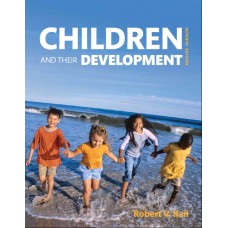This is completed downloadable of Solution Manual for Kail, Children and Their Development, 7th Edition

Product Details:
- ISBN-10 : 0133939170
- ISBN-13 : 978-0133939170
- Author: Robert V. Kail
Organized topically and focused on practice, REVEL for Children and Their Development, Seventh Edition shows students the way scientists actually conduct research and study the discipline. A well-known and respected researcher in the field of child development, author Robert V. Kail provides a path to explore the theory, research, and application of modern child development from conception through adolescence. REVEL for Children and Their Development’s accessible writing, modular format, and application-based features are designed to work together to help students see how research translates into practice.
Table of Content:
- Title Page
- Copyright Page
- Acknowledgments
- Contents
- Welcome
- About the Author
- 1 The Science of Child Development
- 1.1 Setting the Stage
- Historical Views of Children and Childhood
- Origins of a New Science
- Applying Results of Research
- 1.2 Foundational Theories of Child Development
- The Biological Perspective
- The Psychodynamic Perspective
- The Learning Perspective
- The Cognitive-Developmental Perspective
- The Contextual Perspective
- 1.3 Themes in Child-Development Research
- Continuity of Development
- Impact of Nature and Nurture
- The Active Child
- Links Between Different Domains of Development
- 1.4 Doing Child-Development Research
- Measurement in Child-Development Research
- General Designs for Research
- Designs for Studying Age-Related Change
- Ethical Responsibilities
- Communicating Research Results
- See for Yourself
- Summary
- Test Yourself
- Key Terms
- 2 Genetic Bases of Child Development
- 2.1 Mechanisms of Heredity
- The Biology of Heredity
- Single Gene Inheritance
- Cultural Influences: Why Do African Americans Inherit Sickle-Cell Disease?
- Genetic Disorders
- Improving Children’s Lives: Genetic Counseling
- 2.2 Heredity, Environment, and Development
- Behavioral Genetics
- Focus on Research: Hereditary Bases of Children’s Peer Relationships
- Paths from Genes to Behavior
- Unifying Themes: Nature and Nurture
- See for Yourself
- Summary
- Test Yourself
- Key Terms
- 3 Prenatal Development, Birth, and the Newborn
- 3.1 From Conception to Birth
- Period of the Zygote (Weeks 1–2)
- Period of the Embryo (Weeks 3–8)
- Period of the Fetus (Weeks 9–38)
- Improving Children’s Lives: Five Steps Toward a Healthy Baby
- 3.2 Influences on Prenatal Development
- General Risk Factors
- Spotlight on Theories: A Theory of the Risks Associated with Teenage Motherhood
- Teratogens
- How Teratogens Influence Prenatal Development
- Prenatal Diagnosis and Treatment
- 3.3 Happy Birthday!
- Labor and Delivery
- Approaches to Childbirth
- Adjusting to Parenthood
- Focus on Research: Links Between Maternal Depression and Children’s Behavior Problems
- Birth Complications
- Cultural Influences: Infant Mortality
- 3.4 The Newborn
- Assessing the Newborn
- The Newborn’s Reflexes
- Newborn States
- Child Development and Family Policy: Safe Sleeping
- Perception and Learning in the Newborn
- Unifying Themes: Continuity
- See for Yourself
- Summary
- Test Yourself
- Key Terms
- 4 Growth and Health
- 4.1 Physical Growth
- Features of Human Growth
- Mechanisms of Physical Growth
- Improving Children’s Lives: What’s the Best Food for Babies?
- The Adolescent Growth Spurt and Puberty
- Cultural Influences: Adolescent Rites of Passage
- Spotlight on Theories: A Paternal Investment Theory of Girls’ Pubertal Timing
- 4.2 Challenges to Healthy Growth
- Malnutrition
- Eating Disorders: Anorexia and Bulimia
- Focus on Research: Evaluating a Program for Preventing Eating Disorders
- Obesity
- Disease
- Accidents
- 4.3 The Developing Nervous System
- Organization of the Mature Brain
- The Developing Brain
- Child Development and Family Policy: Teenagers and the Law
- Unifying Themes: Connections
- See for Yourself
- Summary
- Test Yourself
- Key Terms
- 5 Perceptual and Motor Development
- 5.1 Basic Sensory and Perceptual Processes
- Smell, Taste, and Touch
- Hearing
- Improving Children’s Lives: Hearing Impairment in Infancy
- Seeing
- Integrating Sensory Information
- Spotlight on Theories: The Theory of Intersensory Redundancy
- 5.2 Complex Perceptual and Attentional Processes
- Perceiving Objects
- Attention
- Attention Deficit Hyperactivity Disorder
- Child Development and Family Policy: What’s the Best Treatment for ADHD?
- 5.3 Motor Development
- Locomotion
- Cultural Influences: Cultural Practices That Influence Motor Development
- Fine-Motor Skills
- Focus on Research: Adjusting Grasps to Objects
- Physical Fitness
- Unifying Themes: Active Children
- See for Yourself
- Summary
- Test Yourself
- Key Terms
- 6 Theories of Cognitive Development
- 6.1 Setting the Stage: Piaget’s Theory
- Basic Principles of Piaget’s Theory
- Stages of Cognitive Development
- Piaget’s Contributions to Child Development
- 6.2 Modern Theories of Cognitive Development
- The Sociocultural Perspective: Vygotsky’s Theory
- Cultural Influences: How Do Parents in Different Cultures Scaffold Their Children’s Learning?
- Information Processing
- Core-Knowledge Theories
- 6.3 Understanding in Core Domains
- Understanding Objects and Their Properties
- Focus on Research: Distinguishing Liquids from Solids
- Understanding Living Things
- Understanding People
- Improving Children’s Lives: Theory of Mind in Autism
- Unifying Themes: Active Children
- See for Yourself
- Summary
- Test Yourself
- Key Terms
- 7 Cognitive Processes and Academic Skills
- 7.1 Memory
- Origins of Memory
- Strategies for Remembering
- Knowledge and Memory
- Spotlight on Theories: Fuzzy Trace Theory
- Child Development and Family Policy: Interviewing Children Effectively
- 7.2 Problem Solving
- Developmental Trends in Solving Problems
- Features of Children’s and Adolescents’ Problem Solving
- Scientific Thinking
- Focus on Research: Learning to Design Experiments
- 7.3 Academic Skills
- Reading
- Improving Children’s Lives: Rhyme Is Sublime Because Sounds Abound
- Writing
- Knowing and Using Numbers
- Cultural Influences: Fifth Grade in Taiwan
- Unifying Themes: Active Children
- See for Yourself
- Summary
- Test Yourself
- Key Terms
- 8 Intelligence and Individual Differences in Cognition
- 8.1 What Is Intelligence?
- Psychometric Theories
- Gardner’s Theory of Multiple Intelligences
- Sternberg’s Theory of Successful Intelligence
- Cultural Influences: How Culture Defines What is Intelligent
- 8.2 Measuring Intelligence
- Binet and the Development of Intelligence Testing
- Features of IQ Scores
- Hereditary and Environmental Factors
- Child Development and Family Policy: Providing Children with a Head Start for School
- Impact of Ethnicity and Socioeconomic Status
- Focus on Research: Making Tests Less Threatening
- 8.3 Special Children, Special Needs
- Gifted Children
- Improving Children’s Lives: Fostering Creativity
- Children with Disability
- Spotlight on Theories: Impaired Reading Comprehension Is Impaired Language Comprehension
- Unifying Themes: Nature and Nurture
- See for Yourself
- Summary
- Test Yourself
- Key Terms
- 9 Language and Communication
- 9.1 The Road to Speech
- Elements of Language
- Perceiving Speech
- Child Development and Family Policy: Are Cochlear Implants Effective for Young Children?
- First Steps to Speech
- 9.2 Learning the Meanings of Words
- Understanding Words as Symbols
- Fast Mapping Meanings to Words
- Spotlight on Theories: A Shape-Bias Theory of Word Learning
- Individual Differences in Word Learning
- Focus on Research: Why Does Exposure to Parents’ Speech Increase Children’s Vocabulary?
- Encouraging Word Learning
- Cultural Influences: Growing Up Bilingual
- Beyond Words: Other Symbols
- 9.3 Speaking in Sentences
- From Two-Word Speech to Complex Sentences
- Mastering Grammar
- Improving Children’s Lives: Promoting Language Development
- 9.4 Using Language to Communicate
- Taking Turns
- Speaking Effectively
- Listening Well
- Unifying Themes: Connections
- See for Yourself
- Summary
- Test Yourself
- Key Terms
- 10 Emotional Development
- 10.1 Emerging Emotions
- The Function of Emotions
- Experiencing and Expressing Emotions
- Improving Children’s Lives: “But I Don’t Want to Go to School!”
- Recognizing and Using Others’ Emotions
- Regulating Emotions
- 10.2 Temperament
- What Is Temperament?
- Spotlight on Theories: A Theory of the Structure of Temperament in Infancy
- Hereditary and Environmental Contributions to Temperament
- Cultural Influences: Why Is Yoshimi’s Son So Tough?
- Stability of Temperament
- Temperament and Other Aspects of Development
- Focus on Research: Temperament Influences Outcomes in Adolescence and Adulthood
- 10.3 Attachment
- The Growth of Attachment
- The Quality of Attachment
- Child Development and Family Policy: Determining Guidelines for Child Care for Infants and Toddlers
- Unifying Themes: Active Children
- See for Yourself
- Summary
- Test Yourself
- Key Terms
- 11 Understanding Self and Others
- 11.1 Who Am I? Self-Concept
- Origins of Self-Recognition
- The Evolving Self-Concept
- The Search for Identity
- Cultural Influences: Dea’s Ethnic Identity
- 11.2 Self-Esteem
- Developmental Change in Self-Esteem
- Variations in Self-Esteem Associated with Ethnicity and Culture
- Sources of Self-Esteem
- Low Self-Esteem: Cause or Consequence?
- 11.3 Understanding Others
- Describing Others
- Understanding What Others Think
- Prejudice
- Spotlight on Theories: Developmental Intergroup Theory
- Focus on Research: Who Is Resilient in the Face of Discrimination?
- Child Development and Family Policy: Ending Segregated Schools
- Unifying Themes: Nature and Nurture
- See for Yourself
- Summary
- Test Yourself
- Key Terms
- 12 Moral Understanding and Behavior
- 12.1 Self-Control
- Beginnings of Self-Control
- Influences on Self-Control
- Improving Children’s Self-Control
- Focus on Research: Engaging Preschool Children to Help Them Delay Gratification
- 12.2 Reasoning About Moral Issues
- Piaget’s Views
- Kohlberg’s Theory
- Beyond Kohlberg’s Theory
- Cultural Influences: Lies, White Lies, and Blue Lies
- 12.3 Helping Others
- Development of Prosocial Behavior
- Skills Underlying Prosocial Behavior
- Situational Influences
- The Contribution of Heredity
- Socializing Prosocial Behavior
- 12.4 Aggression
- Change and Stability
- Roots of Aggressive Behavior
- Spotlight on Theories: Social-Information-Processing Theory and Children’s Aggressive Behavior
- Victims of Aggression
- Child Development and Family Policy: The KiVa Antibullying Program
- Unifying Themes: Continuity
- See for Yourself
- Summary
- Test Yourself
- Key Terms
- 13 Gender and Development
- 13.1 Gender Stereotypes
- How Do We View Men and Women?
- Learning Gender Stereotypes
- Focus on Research: Reasoning About Gender-Related Properties
- 13.2 Differences Related to Gender
- Differences in Physical Development and Behavior
- Differences in Intellectual Abilities and Achievement
- Cultural Influences: A Cross-Cultural Look at Gender Differences in Math
- Differences in Personality and Social Behavior
- Frank Talk About Gender Differences
- 13.3 Gender Identity
- The Socializing Influences of People and the Media
- Cognitive Theories of Gender Identity
- Spotlight on Theories: Gender-Schema Theory
- Biological Influences
- 13.4 Gender Roles in Transition
- Emerging Gender Roles
- Beyond Traditional Gender Roles
- Improving Children’s Lives: Encouraging Valuable Traits, Not Gender Traits
- Unifying Themes: Connections
- See for Yourself
- Summary
- Test Yourself
- Key Terms
- 14 Family Relationships
- 14.1 Parenting
- The Family as a System
- Styles of Parenting
- Parental Behavior
- Influences of the Marital System
- Children’s Contributions
- 14.2 The Changing Family
- Impact of Divorce on Children
- Improving Children’s Lives: Helping Children Adjust After Divorce
- Focus on Research: Evaluation of a Program to Help Parents and Children Adjust to Life After Divorce
- Blended Families
- The Role of Grandparents
- Cultural Influences: Grandmothers in African American Families
- Children of Gay and Lesbian Parents
- 14.3 Brothers and Sisters
- Firstborn, Laterborn, and Only Children
- Child Development and Family Policy: Assessing the Consequences of China’s One-Child Policy
- Qualities of Sibling Relationships
- 14.4 Maltreatment: Parent–Child Relationships Gone Awry
- Consequences of Maltreatment
- Causes of Maltreatment
- Preventing Maltreatment
- Unifying Themes: Active Children
- See for Yourself
- Summary
- Test Yourself
- Key Terms
- 15 Influences Beyond the Family
- 15.1 Peers
- Development of Peer Interactions
- Friendship
- Focus on Research: Influence of Best Friends on Sexual Activity
- Romantic Relationships
- Groups
- Popularity and Rejection
- Cultural Influences: Keys to Popularity
- 15.2 Electronic Media
- Television
- Improving Children’s Lives: Get the Kids Off the Couch!
- New Media
- 15.3 Institutional Influences
- Child Care and After-School Activities
- Part-Time Employment
- Neighborhoods
- Spotlight on Theories: The Family Economic Stress Model
- School
- Unifying Themes: Continuity
- See for Yourself
- Summary
- Test Yourself
- Key Terms
- Glossary





